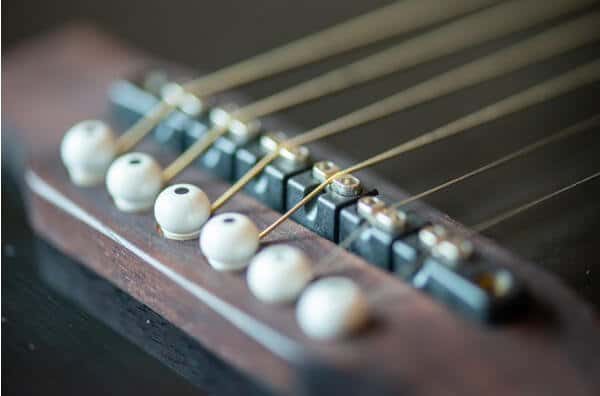Table of Contents
There are many reasons why one would want to put nylon strings on a steel-string guitar. Perhaps you like the sound of them but don’t want a classical guitar. Maybe you just have a guitar lying around that you want to repurpose. Can you put nylon strings on a steel-string guitar?
Yes, you can put nylon strings on a steel-string acoustic guitar. But getting them to sound and play well might not be easy. There is a tension difference between these string types. This can affect your guitar poorly. It will also be hard to mount nylon strings to a guitar made for steel.
There are things that need to be considered before putting nylon on a guitar. This Killer Rig article aims to provide all the information you need to make the decision, as well as tackle to job!
The Pros and Cons
Switching from steel to nylon strings on an acoustic guitar requires careful consideration. Evaluate your musical needs, playing style, and desired tone before making the change. Here are the pros and cons to making this kind of change:
Pros
1. Easier on the Fingers
Nylon strings are softer than steel strings, which makes pressing down on the frets less painful. This is beneficial for beginners and those with sensitive fingertips.
2. Mellow Sound
Nylon strings produce a softer, more rounded sound compared to the bright and crisp tone of steel. This is suitable for genres such as classical, jazz, and folk.
3. Lower Tension
The tension in nylon strings is lower compared to steel-strings. This results in less stress on the guitar’s neck and bridge, which may extend the lifespan of the instrument.
4. Versatility
Nylon strings can be used in various music styles, providing a broader range of sound options.
Cons
1. Limited Volume and Sustain
Nylon strings do not produce as much volume and sustain as steel. This may be a disadvantage for those looking to produce a louder sound.
2. Tuning Instability
Nylon strings are more sensitive to changes in temperature and humidity, leading to more frequent tuning adjustments.
3. Structural Concerns
The lower tension of nylon strings can sometimes result in insufficient neck relief, which may affect playability.
4. Limited Style Suitability
Nylon strings are generally not suitable for genres that require a bright, cutting tone or intricate fingerpicking, such as rock, country, or bluegrass.
Can You Put Nylon Strings On a Steel-String Guitar?
Yes, it’s possible to put nylon string on an acoustic made for steel strings. Yet, you might experience issues with neck warping. The tension is much different with nylon strings. Tuning and intonation issues might arise as well. But this isn’t the same with every acoustic guitar.
There are many players who like the sound of nylon strings but don’t care much for the width of a classical guitar neck. The action on the neck and width need some getting used to. But not every player wants to have to relearn the neck just to get the warmer sound that they can give.
And so repurposing a steel-string acoustic guitar is usually easier to do. But these materials don’t behave the same way. Most players see the first challenge immediately. Most nylon strings tie to the bridge of a classical guitar!
This presents a big problem as the ball ends on steel strings are crucial to having them tense properly. Without them, they will slip right off. And not only that, but it’s not possible to tie nylon to some bridges that are made for steel. But don’t lose hope yet, we have some good news for you!

Ball-End Nylon Strings
The good news is that there are nylon strings available with ball ends that solve this dilemma! These are made for the convenience of not having to tie them around the bridge.
They are popular with those who prefer them in place of steel. Even classical players looking for hassle-free installation.
There are many different types available and brands that make them. There are only so many music stores that carry them. Buying online would be the way to go if you cannot find them locally.
And while they are an easy installation on a classical guitar, there are still a few challenges. If you are putting them in place of steel.
Benefits Of Using Nylon Strings
If you have decided that you want to use nylon strings on your acoustic guitar, there are some benefits. Here are a few things you can expect when using them:
- Less String tension will make them easier to press.
- Nylon is softer and easier on your fingers.
- They sound warmer than steel.
- They don’t rust or oxidize.
- Classical music will sound better using nylon.
If your guitar has a cutaway, this is also a rather large benefit, as most classical models do not. So nylon strings on a guitar made for steel can work out good once you deal with any installation issues.
Related Article: Acoustic Vs Classical Guitar.
Are There Risks?
Putting nylon strings on a guitar made for steel doesn’t pose any risks. The nylon doesn’t have the tension to do any damage. The guitar will be a good platform for the strings because it can handle them without issue.
There are no concerns with it hurting the neck. And so tuning should be pretty stable. You will need to adjust the neck to accommodate them at some point.
The biggest issues will be that you can’t use a pick on the nylon. This will wear them out very quickly. And finding a way to mount them might be difficult. But this depends on which ones you use.
How To Put Nylon Strings On An Acoustic Guitar
Switching from steel to nylon strings on a steel-string guitar involves several steps that require careful attention to detail. Below is a step-by-step guide to help you through the process.
Step 1: Gather Necessary Tools and Supplies
- Nylon strings compatible with steel-string guitars
- String winder (optional but recommended)
- Wire cutters
- Tuner
- Guitar support or soft surface
Step 2: Remove Old Strings
- Loosen the tension on the old steel strings using the tuning pegs.
- Cut the strings using wire cutters to make removal easier.
- Remove the strings from the bridge and tuning pegs.
Step 3: Clean and Inspect the Guitar
- With the strings removed, take the opportunity to clean the fretboard.
- Inspect the guitar for any signs of wear or damage, especially around the bridge and nut.
Step 4: Install the Nylon Strings
- Insert the new nylon strings through the bridge.
- Pull the strings through the tuning pegs, leaving some slack for winding.
- Wind the strings onto the tuning pegs, maintaining tension.
Step 5: Stretch and Tune
- Gently stretch the strings by pulling them upward, away from the guitar, to help with tuning stability.
- Use a tuner to bring the strings to their correct pitch.
Step 6: Cut Excess String Length
- Once the strings are tuned and stretched, use wire cutters to remove any excess string length beyond the tuning pegs.
Step 7: Recheck Tuning and Playability
- After cutting the excess, re-tune the guitar.
- Play the guitar to check for any issues with sound or playability.
Precautions
- Ensure that the nylon strings you choose are compatible with steel-string guitars.
- Be cautious when stretching the strings; excessive force can cause them to break.
- If you experience any issues with sound or playability, consult a professional for adjustments.
By following these steps carefully, you can successfully switch from steel to nylon strings on your steel-string guitar. It’s important to note that the change will have various effects on your guitar’s sound and playability, so take the time to familiarize yourself with the new setup.
Wrapping Nylon String Around Tuners
With steel strings, installing them to the tuners can be pretty easy. The steel will mold and form itself as they get tight. This has the benefit of fewer wraps and makes it easy to install. With nylon, depending on the tuner, they might slip out when wrapping them.
Some nylon strings might require more wraps or some overlap to hold them onto the tuner. Once you can get them tightened up, this usually goes away. But finding the right amount of wraps and technique could take a few tries. This isn’t a reason to avoid it, but it’s something to consider.
Nut Groove Size
Another thing to consider is the groove sizes on the nut. If you move to a different string gauge with the nylon, it might be too big. It will be a good idea to make sure your nut is in good shape and can handle the new strings.
If the grooves are too small, this can be remedied by opening them up. If the material is too hard, on the other hand, then you might have to inquire with a technician. Again, not a dealbreaker, but something to look out for.
Tuning Nylon Strings
If you have not tuned nylon strings before, you will need to know what to expect. With steel, after you put on a new set and adjust the tension, it is quite easy to get it close quickly. They will stretch for a bit, but it’s not a big deal.
- Nylon strings typically have a tension of 80-85 lbs.
- Steel stings are much tighter at 150-160 lbs.
With this new material, it will stretch a great deal before even coming close to the right pitch. It could take a few days and 8 to 10 adjustments before they begin to hold proper tuning.
You might think that they are slipping at first, but it could just be that they are stretching to the new tension. And while it could very well be slipping, as we touched on above, you will need to monitor that as well.
If this is the first time you put nylon strings on. Especially a steel-string guitar, just be aware of this rather large difference.
Some players have also tuned down a bit lower from standard with nylon strings. If you find the guitar setup just doesn’t feel right, you might also want to try this.
One would assume that the lower, warmer sound would be what you are expecting. And so to also get the proper feel, tuning down slightly should also help.
Truss Rod Adjustment
With steel-string guitars, the tension is much greater than that of a classical. Nylon strings don’t require as much tension, so your guitar might need an adjustment to the neck.
If you find that there is considerable fret buzz, then you need a change in accuracy.
The steel strings bow the neck differently than nylon would. And so a proper setup of the truss rod will be needed to fix the issue. Planning to have this guitar remain with strings of this new material? Then a trip to see a technician for a full setup is well worth it.

Nylon Strings and Bridge Pins
In order to use nylon strings on an acoustic made for steel, you must select and use the right ones. Not all nylon strings can be used on a guitar with bridge pins, so you must get a certain type.
There are some manufacturers that make nylon strings with ball ends. The same type of configuration you would find with regular steel strings. This allows you to string a guitar easier as well as use different bridge types.
Not everyone can tie nylon strings on a bridge, and without ball ends, you are limited in how you can use them. But because string makers have been listening, you can now get them and install them where you need them.
D’addario makes a great set that can be used on many acoustic guitar types. They are EJ34 folk nylon strings and a great option. Not only can you use them on guitars made for steel strings, they are also super easy to put on!
FAQs
Can You Put Steel Strings on a Classical Guitar?
No, putting steel strings on a classical guitar will ruin it. This material requires far more tension than nylon does to tune properly to pitch. If you were to put steel on a classical guitar, the neck would break away from the body.
This is because classical guitars are not reinforced to handle the tension. With nylon, there is less tension. So classical guitars are only reinforced enough to handle them. You are better off-putting bass strings on an electric than steel on a flamenco!
Is it Easier to Play Guitar with Nylon Strings?
Playing nylon strings is much easier on your fingers than steel! They are more forgiving if you don’t have calluses. They are also less tense, so using them is much different. For a beginner, they are great. Especially while they begin to strengthen their fingers and develop calluses.
But no player should ever play this material if their music is not classically based. Always select the guitar and string type that matches your favorite music. You want to be inspired to play, and using the right tools will do that.
Don’t use nylon strings because it is easier on your fingers but will not be the sound you want. You will get bored and quit!
Can I Use a Pick on Nylon Strings?
Using a pick with nylon strings is perfectly fine. But keep in mind that they will wear more quickly. This of course depends on how aggressively you strum and the choice of music. The pick will create some friction on them and the nylon will eventually wear away.
But like all strings, this is inevitable anyway and should not be the reason to choose something else. With guitar, always choose what sounds good to your ear.

